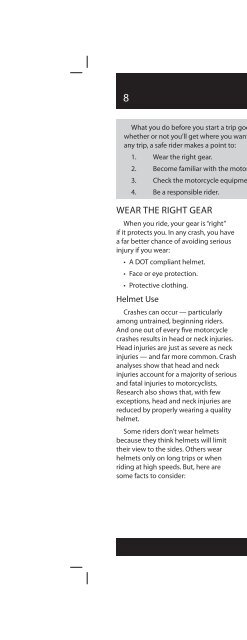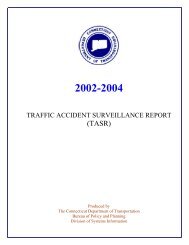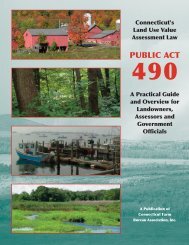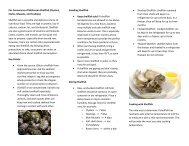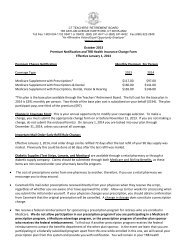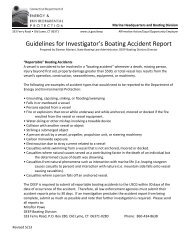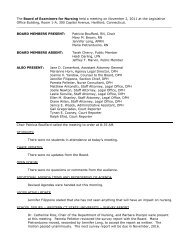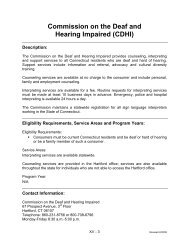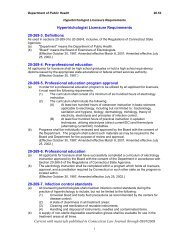The Connecticut Motorcycle Operator's Manual - CT.gov
The Connecticut Motorcycle Operator's Manual - CT.gov
The Connecticut Motorcycle Operator's Manual - CT.gov
Create successful ePaper yourself
Turn your PDF publications into a flip-book with our unique Google optimized e-Paper software.
8 PREPARING TO RIDE<br />
What you do before you start a trip goes a long way toward determining<br />
whether or not you’ll get where you want to go safely. Before taking off on<br />
any trip, a safe rider makes a point to:<br />
1. Wear the right gear.<br />
2. Become familiar with the motorcycle.<br />
3. Check the motorcycle equipment.<br />
4. Be a responsible rider.<br />
WEAR THE RIGHT GEAR<br />
When you ride, your gear is “right”<br />
if it protects you. In any crash, you have<br />
a far better chance of avoiding serious<br />
injury if you wear:<br />
• A DOT compliant helmet.<br />
• Face or eye protection.<br />
• Protective clothing.<br />
Helmet Use<br />
Crashes can occur — particularly<br />
among untrained, beginning riders.<br />
And one out of every fi ve motorcycle<br />
crashes results in head or neck injuries.<br />
Head injuries are just as severe as neck<br />
injuries — and far more common. Crash<br />
analyses show that head and neck<br />
injuries account for a majority of serious<br />
and fatal injuries to motorcyclists.<br />
Research also shows that, with few<br />
exceptions, head and neck injuries are<br />
reduced by properly wearing a quality<br />
helmet.<br />
Some riders don’t wear helmets<br />
because they think helmets will limit<br />
their view to the sides. Others wear<br />
helmets only on long trips or when<br />
riding at high speeds. But, here are<br />
some facts to consider:<br />
• A DOT compliant helmet lets<br />
you see as far to the sides as<br />
necessary. A study of more than<br />
900 motorcycle crashes, where<br />
40% of the riders wore helmets,<br />
did not fi nd even one case in which<br />
a helmet kept a rider from spotting<br />
danger.<br />
• Most crashes happen on short<br />
trips (less than fi ve miles long), just<br />
a few minutes after starting out.<br />
• Most riders are riding slower than<br />
30 mph when a crash occurs. At<br />
these speeds, helmets can cut both<br />
the number and the severity of head<br />
injuries by half.<br />
No matter what the speed, helmeted<br />
riders are three times more likely to<br />
survive head injuries than those not<br />
wearing helmets at the time of the<br />
crash. <strong>The</strong> single most important thing<br />
you can do to improve your chances of<br />
surviving a crash is to wear a securelyfastened,<br />
quality helmet.<br />
Helmet Selection<br />
<strong>The</strong>re are two primary types of<br />
helmets, providing two diff erent levels<br />
of coverage: three-quarter and full face.<br />
Whichever style you choose, you can<br />
get the most protection by making sure<br />
that the helmet:


